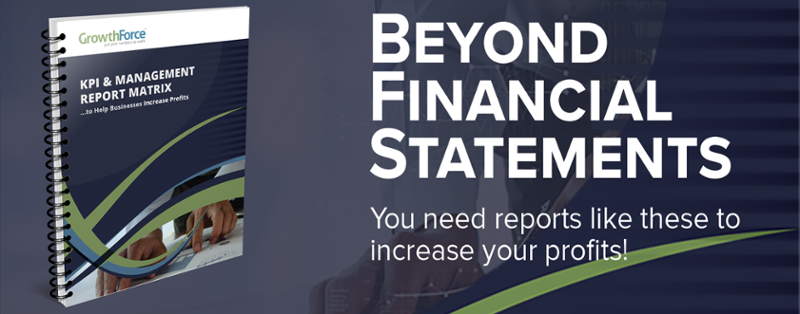
As you are well into the second half of the year, hopefully your company is seeing an upward trend across a variety of key performance indicators. Obviously increased profits is the end-game, but smaller gains such as an increase in qualified sales leads, closing higher margin deals and more repeat customers are always good news – and signs of good things are on the horizon.
For the more fortunate business owners, the rubber really hit the road in Q2 – leading to rapid growth in new client acquisitions or sales totals that exceeded expectations. If that’s the case, first of all, congratulations are in order! Then what?
If you want to maintain momentum, you need to make sure you’re growing all aspects of your business in tandem to deal with the new levels of work that need to be managed. If you are growing, you need to upgrade your financial reporting and also invest in company culture.
Company culture has a big impact on how business handles growth and a tremendous impact company’s finances, that’s why we mention it here.
3 Issues You Need To Monitor and Manage During Unexpected Growth
1. Will you need more capital to finance this growth?
When sales go up you need working capital to fulfill the orders before you get paid for them. If you make money on your people, you need to add more staff. If not, you often have to buy inventory to ensure customers are happy and orders continue to go out on time. Profitable businesses keep both new and repeat customers happy. After all, delayed shipment can mean that those new customers are lost just as fast as they were earned.
More people mean more fixed costs. You have to watch that stair step increase in payroll and have the cash to pay them if you have a gradual slope of increased revenue.
In order to keep products in stock and ready to roll, you’ll need to be spending more with your own suppliers and vendors. How much are your own orders going up? How long does it take to get it in stock? And how long does it take to recoup that cost? For instance, if you aren’t charging your customers until products ship or the services are delivered, but you have to pay your staff and vendors upfront, there’s an uneven cash flow going in and out. Do you have enough capital to cover the in-between while you wait for the revenue?
2. Do you have the ability to properly manage services or orders in and out?
With a huge influx in service clients or customer orders, how can you be sure that an invoice or two isn't slipping through the cracks? Is your accounts receivable department keeping pace? Is your team updating your accounting system to reflect which customers have been invoiced, who has paid - and who has not?
The last thing you can afford to find out is if you have outgrown your billing clerk. Smaller companies might have only one person processing the orders and handling all of the accounts receivable responsibilities. As you grow, is this person able to manage all of the paperwork in a timely manner? Do you have procedures in place to ensure the information is accurate? Are you placing too much trust on a single point of failure?
Sometimes "the way it's always been done" isn't the most efficient method, and when dealing with an unexpected surge in business, financial processes and internal controls need to grow right alongside your expanding business.
Achieving breakthrough results is a huge triumph for any small business owner. Take time to celebrate, but make certain that keep your finger on the financial pulse of your business so you can continue making strategic decisions that move your business forward.
Now’s the time to evaluate how your business manages the financial operations to make sure you’re not driving blind. If you currently lack timely, accurate and meaningful financial intelligence, then consider outsourcing your accounting to a dedicated team of professionals so you can stay focused on what matters most – growing your business.
3. Do you need to hire more staff?
When your business experiences growth, your employees feel it too. Your regular staff will be doing more work to keep pace with the increased demand. Your employees will be more likely to handle the momentum if they are happy, motivated and productive.
While low productivity can be a concern, the biggest problem facing many small-to mid-sized companies is turnover. The financial impact of turnover is high.
According to some studies, it costs an average of six to nine months' of an employee's base salary to replace them.1 And for at least one in five companies, the costs exceed $50,000.2
The best candidates want to work in a positive, supportive environment that aligns with their core values and provides them with interesting work. When you communicate your core values and company culture to candidates up front, you increase the odds of attracting candidates who are passionate about your business—and who are more likely to be high performers who stay with you for the long haul because they believe in what they’re doing.
If you need to hire, but hire too far in advance, you'll put people on a payroll that can't support the cost without increased production.
On the other hand, when you onboard and train new staff members right when you need them, your new employees can hit the ground running. When the timing is right, you'll smooth out your stair step profitability, and prevent the added expense that can be incurred from hiring too early.
If you make money on people’s time, the value of your business lies with your employees—the people who understand and share your strategic vision, have in-depth knowledge of your intellectual property and processes, and possess the ability to help drive your company forward.
It’s important to realize that the most important sale you’ll ever make isn’t to any customer. Instead, it’s to an A-player employee who’ll join your company, help you build a high-performing team and add to your momentum. And that’s why you can’t hire just anyone to work for you.
Companies that experience growth are doing something right, but managing your finances before, during and after growth is what will lead to long term success.
We recommend downloading the The KPI & Management Report Matrix, for a sample set of 12 management KPIs that are designed to help you see what reports you should be looking at to drive growth and profitability in your business.
Sources:
1https://www.zanebenefits.com/blog/bid/312123/employee-retention-the-real-cost-of-losing-an-employee 2http://resources.careerbuilder.com/small-business/the-hidden-costs-of-bad-hires-on-small-businesses

.png?width=563&height=144&name=New%20GF%20Logo%20(37).png)
